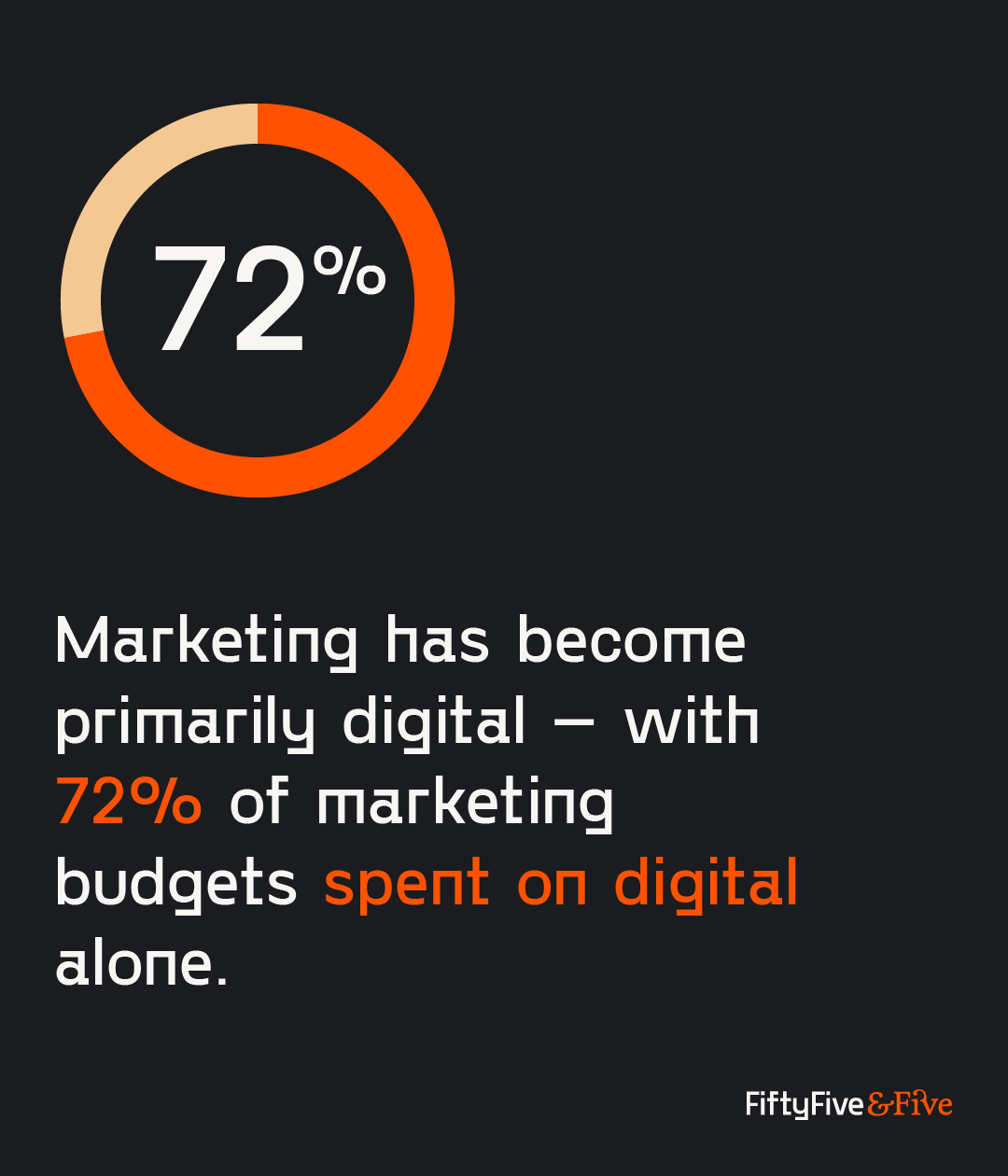For the best return on your money, pour your purse into your head.
"Every company is a technology company". That's what Accenture's CET and CEO, Paul Daugherty said back in 2020. It's never been more apparent that technology is changing the way businesses work, with the rise of AI tools pushing us to ask bigger questions of our marketing.
Digital marketing, as the name might suggest, is born of technology. We're right in the centre. And as a tech agency, if we're not up to date with the latest, we're as good as done.
So, I've reached out to our marketing team at Fifty Five and Five to understand the seven digital marketing technologies that we use to measure your success (and, yes mine) in reaching your audience, and how they help you to raise your game:
- Social media
- Paid media
- SEO tools
- Email marketing platforms
- Analytics and reporting software
- Training software
- Outreach tools
But first things first...
What is marketing technology?
Marketing technology, or MarTech, is the blanket term used for all digital platforms and tools that help marketers to streamline, automate and analyse their marketing efforts. If Batman has his utility belt, then marketers have MarTech.

Marketing has become an art that's primarily digital - with 72% of marketing budgets spent on digital alone. And no matter what you're selling, and to whom, technology can improve the quality of your marketing output and, ultimately, helps generate more leads.
Marketing technologies allow you to:
- Measure the results and impact of your campaigns
- Monitor engagement and interactions across social, websites and paid media
- Pinpoint campaign strengths and weaknesses and make meaningful changes
- Attain actionable insights to optimise for greater ROI
- Reduce the time taken in gathering analytics and generating campaigns
I've seen the benefits each day that our arsenal of tools brings to the marketing team. They help us channel our creativity, easily manage our workloads, and to monitor, measure and present incredible results to our clients.
Let's take a closer look, shall we?
Social Media
Building a unique brand identity, engaging with existing customers, finding new audiences, insightful thought leadership - that's what social media is for.

TCS social media campaign for marathon events
Some marketing teams invest hours in social media management, but don't have the ROI to show for it. Social is all about having the right tools to enable greater visibility over social channels, deliver detailed performative insights and optimise social media management.
Here are some of our favourites:
Hootsuite
We love Hootsuite! It's one of the most popular tools for enhancing social media output; supporting over 250 integrations and allowing users to update multiple networks in one step. It's also capable of analysing over 300 metrics, so we can create a dashboard that perfectly tracks your business's goals. Hootsuite is the perfect tool for social media management. It's, quite simply, a hoot (sorry).
Sprout Social
If you hate sprouts as much as I do, then the name probably didn't grab you. But don't panic. It doesn't ruin Sunday roasts. Sprout Social does help us build stronger relationships with your customers. The social media scheduling, monitoring and reporting platform offers a customer relationship manager (CRM) feature. This enables our team to create individual profiles of your customers and, yes, develop better connections that deliver results.
Sprinklr
We use Sprinklr to help one of our clients schedule posts, create reports, pool in data and more. Beyond that, we have found Sprinklr to be a useful tool for researching and understanding campaign audiences, and for social listening. So, it's a worthy addition to our social media toolkit.
We brought the TCS 'Building on Belief' brand message to life with this social marketing strategy.
Paid media
Out of all the marketing technologies, paid media can be the most difficult to get right (trust me, I've written a few paid campaigns in my time). It takes a lot of research and precise positioning to get things moving.
By using the correct tools, we target the right demographic, track paid campaigns and develop a competitive long-term strategy that works for our clients. We understand how to use a third-party platform to extend visibility of your advert placements and find a larger audience. Plus, we help you to target your audience more effectively and reduce your overall spend.
These tools allow us to deliver exceptional returns:
SpyFu
SpyFu enables us to carry out PPC research on your competitors. Whether it's your competitor's estimated monthly spend, the keywords that they are targeting or how well their ads are ranking, SpyFu provides us with the insights we need to put together a highly competitive campaign strategy that meets your requirements.
SEMrush
SEMrush offers an extensive keyword database that's difficult to match and makes building ads simple - using information about the ads posted by your competitors to ensure that you can outmanoeuvre them when you need to. This powerful audience targeting means your PPC campaigns have a greater chance of succeeding.
Leadpages
We find that Leadpages is a tool that's suited for smaller businesses that are looking to engage with their core audience on social media channels. It acts as a funnel, sending your target audience to a specific landing page designed for them. Also, it integrates with Google Ads and Facebook Ads, allowing us to capture your leads effectively and quickly.
Here are 4 tips from our paid media experts to guarantee international PPC success.
SEO tools
Now it's time for the big beast of marketing technologies: search engine optimisation (SEO). SEO is all about staying visible on search engine results pages...and watching out for the ever-changing algorithms.
SEO is tricky, and almost impossible to manage without the right tools. Without some kind of SERP analysis tool, or keyword research, you're basically trying to fight a bear blindfolded.
Here are the SEO tools that can help you climb those results pages:
Ahrefs
Switching from Moz to Ahrefs has been a decision that we haven't looked back on. The comprehensive platform covers so much - from page rankings, Domian Authority scores, backlinking and more. And while the dashboard is extensive, we use Ahrefs mostly for keyword research. Using data from a wide source of search engines, we get an expansive overview of search volumes, matching keywords, competitor research and more to find keywords that work.
AnswerThePublic
Well known for its spirally results pages, AnswerThePublic helps us to select long-tail keywords that are suitable for campaigns and other content. The free platform also displays a full overview of what users are asking, as well as keywords that aren't available on Ahrefs. It is a little less data heavy than Ahrefs, focusing instead on search intent and semantics. A really useful addition that helps us build a more rounded SEO strategy.
Screaming Frog
No frogs were killed during the development of this platform (at least, I don't think so). Screaming Frog has become another trusty SEO tool. The indexing and crawling platform enables us to see all URLs, redirect chains, broken links and more on a client's website so we can take decisive action. Unlike Ahrefs, the URLs in the dashboard are cleaner, tidier and easier to explore - making our job simpler.
Google Search Console
We have found many aspects of this platform to be essential for troubleshooting, reporting and performance-related SEO tasks. From keyword performance to page experience, top performing pages, CTR performance and A/B testing, Google Search Console has helped us get to the nitty-gritty of delivering SEO insights that matter.
Ready to take your website to the next level and generate leads with our SEO services?
Email marketing platforms
How full is your inbox right now? If it's anything like mine, then I'm sure it's awash with many emails trying to compete for your attention.
Email marketing is all about nurturing leads into prospects, and prospects into customers, creating a dialogue with your audience, and sending them targeted (and personalised) updates to pique their interest.
But with so much competition, we know that creating a successful campaign requires more than open rates; you need click-throughs, conversions and email content that offers actual value for the reader.
Here's the key tool we use:
MailChimp
No surprises here. MailChimp is our no.1 choice for email marketing. It allows us to automate our email marketing with simple A/B testing, ready-to-use campaign templates and a simple email designer. The 'MailChimp reports' also make it easy to track how successful our emails are at engaging with our audience, using advanced segmentation for precise targeting, distribution by time zone and comparative data reporting.
Analytics and reporting software
Among the creative campaigns, PR stunts and outlandish collabs, marketing is very much a numbers game at heart. Reporting is about justifying future investment in marketing efforts. So, if it ain't making you money, it ain't working.
We do it all the time with monthly reports to clients: showing progress, highlighting peaks and pinpointing gaps that campaigns can occupy and how to improve in future.
Here's what we use to gather our results:
Google Data Studio
Google Data Studio collects real-time data from YouTube, Google Ads and Google Analytics to help create dynamic, interactive dashboards. It's also compatible with multiple third-party data sources like Twitter, MailChimp and Salesforce, which is a huge help to us. Plus, Google Data Studio puts together reports that are fully customisable, easy to filter and easy to share.
Google Analytics 4
We believe Google Analytics 4 (GA4) stands head and shoulders above the rest as a tool for measuring the bigger picture. In particular, it monitors traffic arriving on your website and how site users are behaving. Google's machine learning capabilities mean that GA4 can generate insights you just can't get anywhere else. And we love showcasing this to you! In fact, we love GA4 so much, we even wrote a blog about it.
Adobe Analytics
Similar to Google Analytics, Adobe Analytics shows a range of performance-related stats. We have adopted the tool for a specific client, and while we are still in our infancy of using the tool, we're very much looking forward to seeing it become a part of our toolkit to generate effective results. More on this soon!
TapClicks
Another client favourite, TapClicks is not the dancing platform it sounds like. But it sure does have a few moves to show off. We use it as a dashboard tool to show our clients their data from all campaigns, simply and visually. We customise dashboards to suit their needs so they (and we) can extract real-time and historical data when needed.
Training software
"For the best return on your money, pour your purse into your head." Benjamin Franklin wasn't wrong here. Training is one of the often-overlooked uses of technologies in marketing. But it's one of the most vital for remaining ahead of the curve.
Change is a part of the everyday, especially in marketing and technology. We like to think of training in marketing as a way of investing in the success of our future efforts.
That's why we use the following to train our team:
LinkedIn Learning
LinkedIn Learning covers a wide range of professional courses and tutorial videos which have been a huge benefit to the marketing team. Their ever-growing abilities comes from their dedication to improve so they can constantly deliver the best. There are courses for every level from beginner to expert - with over 16,000 entirely free courses. These include technical aspects of PPC to the writing skills needed for engaging content, and more.
Google Digital Garage
Whether it's the 'fundamentals of digital marketing' course that's extensive enough for any beginner, or any of the other courses, we've found the Digital Garage to be the ideal spot for a marketing spray job. Not a complete makeover, but a chance to upgrade our skills. With a range of courses coming in at over 40 hours, it's worth checking out.
Outreach tools
Leads and prospects are the hidden goal of every campaign. But storing and accessing prospective leads is a mission. You need fast access, and an Excel doc is simply not the answer.
These are the tools we use to counter the problem.
Hunter
We use Hunter to help find the email addresses held within any domain. Our team does a lot of outreach every day, and sometimes it's important for a message to reach a particular person within a business. Enter: Hunter. Simply type a domain into the search box, and Hunter conveniently displays all the email addresses it can find associated with that domain. Very handy for outreach and connecting with leads.
Seamless
Seamless is another useful tool which helps us find contacts and manage prospect information. While it's similar to Hunter, it also features a handy browser extension which integrates with services like LinkedIn, helping us find the right contact information without disrupting our workflow. Pretty neat.
Unlock you digital potential
Ready to harness the power of advanced digital technologies? Our expert team is here to help you elevate your marketing strategies and optimise results. Visit our service pages now and discover how we can transform your business!

